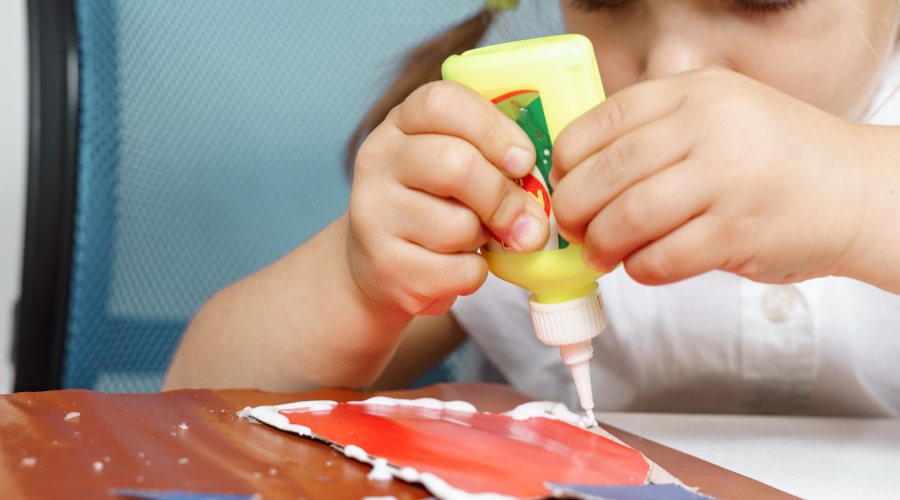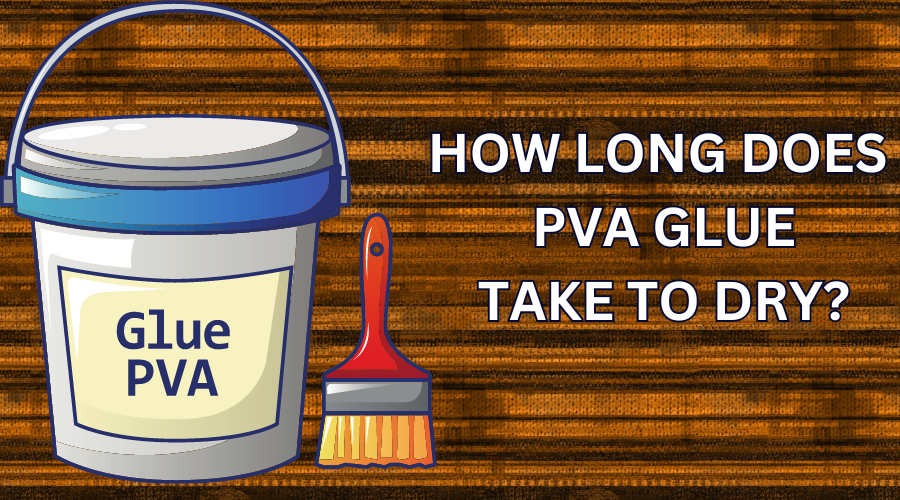If you are a DIY enthusiast, a crafter, or a woodworker, you probably have used PVA glue at some point. PVA glue is a versatile and easy-to-use adhesive that can bond various materials such as paper, wood, fabric, and more.
But how long does it take for PVA glue to dry? And what factors affect the drying time of PVA glue?
In this article, we will answer these questions and give you some tips on how to speed up the drying process of PVA glue.
Whether you are making a collage, a bookcase, or a quilt, you will find this article useful and informative.How Long does PVA Glue Take to Dry?
The drying time of PVA glue depends on several factors, such as the temperature, humidity, thickness, and type of the glue.
PVA glue can be touch dry in 30 minutes to an hour, but it takes 18 to 24 hours to fully cure. To speed up the drying process, you can improve the ventilation, apply thinner layers, use a fan, dehumidifier, or heat lamp, or mix PVA with water.
PVA glue is a versatile and easy-to-use adhesive that can bond various materials such as paper, wood, fabric, and more. It is also used as a primer or sealer for plastering and decorating projects.
What is PVA Glue?
PVA, or Polyvinyl Acetate, is an adhesive particularly popular for wood crafts. Known commonly as ‘PVA glue’ or ‘wood glue’ offers a solid and enduring bond, making it a go-to glue for various wood-based projects.
When you’re working with wood, having a bond that can withstand the test of time and various weather conditions is crucial. Anything less, and your creation will likely fall apart or deteriorate quickly.
Another key point about PVA glue is how it bonds with wood. The bond is incredibly robust, meaning that once the glue has set, it will take something substantially forceful to break it apart.
This quality makes PVA an exceptional adhesive, especially on porous surfaces like wood. Moreover, the clean finish PVA glues outshines many of their counterparts.
PVA Glue Dry and Cure Time
Understanding the dry time and cure time for PVA glue is crucial. Rushing the cure time may result in weak bonds, while waiting too long can affect your work schedule.
PVA glue generally dries in 10-30 minutes. However, don’t be deceived, as drying does not equate to curing. Drying means the water in the glue has evaporated. During this time, the glued pieces can be safely moved without fear of disturbance.
On the other hand, curing refers to the chemical process where the PVA glue attains its maximum strength.
Typically, a full cure time will take around 24 hours. But remember, the cure time can vary based on humidity, temperature, and the amount of glue applied.
So, while you can lightly handle the glued pieces after it dries, remember to allow sufficient time for the actual curing process for a solid and durable outcome.
Why does PVA Glue Take so Long to Dry?
PVA glue, including the high-quality ones manufactured by BritPainter, has a water base. Water takes time to evaporate, which contributes to the glue’s drying time.
Typically, PVA glue dries within 20 to 60 minutes. However, the typical time it takes depends on multiple variables.
Firstly, considering the quantity applied — if you’re using more glue, it will necessitate more drying time.
Secondly, the material you’re working with can influence how long the PVA glue dries. Some materials absorb the glue, speeding up drying, while others do not.
And lastly, environmental conditions such as humidity and temperature play their part. The drier and warmer the conditions, the quicker your glue should dry.
Although PVA glue dries to the touch pretty quickly, that doesn’t mean it’s completely dry. “Dry” and “cure” may sound similar, but they are not.
When PVA glue isn’t sticky anymore, it is dry. But, to reach its maximum strength, it should cure. Curing usually takes about 24 hours. Hence, while it might feel dry, wait for a complete cure before subjecting your project to stress.
Factors Affecting PVA Glue Drying Time
Understanding what affects your glue’s drying time is crucial. But the answer to how long you should wait isn’t set in stone; it varies because several factors influence it.

1. Type of PVA Glue
Different types of PVA glue have different properties and applications, which affect their drying time.
For example, yellow glue and cross-linking PVA glue are more resistant to water and heat than white glue and school glue, but they also have a shorter open time (the time before the glue starts to set) and a faster setting time (the time before the glue becomes tacky).
Aliphatic resin is a type of yellow glue with a longer open time and a higher water resistance, but it also takes longer to dry and cure.
2. Temperature and Humidity
The temperature and humidity of the environment also influence the drying time of PVA glue. Higher temperatures and lower humidity can speed up the evaporation of water from the glue layer, resulting in a faster drying time.
However, if the temperature is too high or the humidity is too low, the glue can dry too quickly and form cracks or bubbles in the bond. Therefore, using PVA glue in a moderate temperature and humidity range is recommended.
3. Thickness of the Glue Layer
The thickness of the glue layer also affects the drying time of PVA glue. A thicker layer of glue will take longer to dry than a thinner layer, as it contains more water that needs to evaporate.
A thicker layer of glue can also create a weaker bond, as it reduces the contact area between the glued surfaces. Therefore, applying a thin and even layer of glue is advised for optimal results.
Comparison of PVA Glues: Determining Which Dry Fastest
Different types of PVA glues have different characteristics and drying times.
Here are some of the main types of PVA glues and how they compare in terms of drying time:
1. White glue:
This is the most basic and widely available type of PVA glue. It has a white colour and a thin consistency. It is good for general-purpose glueing, especially for paper and cardboard.
White glue usually sets in less than 30 minutes and dries in about an hour. It takes up to 24 hours to cure fully.
2. Yellow glue:
This is also known as carpenter’s glue or wood glue. It has a yellow colour and a thicker consistency. It is designed for woodworking projects, as it creates a stronger bond than white glue and is more resistant to water and heat.
Yellow glue typically sets in 10 to 30 minutes and dries in 30 minutes to an hour. It also takes up to 24 hours to cure fully.
3. Aliphatic resin:
This type of yellow glue has a higher water resistance and a longer open time (the time before the glue starts to set). It is ideal for outdoor projects or projects requiring more alignment and clamping time. Aliphatic resin is set for 25 to 30 minutes and dries in one to two hours. It cures in 18 to 24 hours.
4. Cross-linking PVA:
This type of yellow glue has a higher heat resistance and shorter open time. It suits projects requiring a fast setting time and a durable bond. Cross-linking PVA sets in less than 10 minutes and dries in 30 minutes to an hour. It cures in 12 to 18 hours.
5. School glue:
This type of white glue is specially formulated for children’s use. It has a clear or slightly milky colour and a very thin consistency. It is safe, non-toxic, and washable.
It is good for arts and crafts projects, especially paper, fabric, and foam. School glue sets in less than 15 minutes and dries in about an hour. It cures in 24 hours.
As you can see, different types of PVA glues have different drying times depending on their properties and applications. In general, PVA glues set faster than they dry and dry faster than they cure.
How to Make PVA Glue Dry Faster
1. Read the Label:
- PVA glues vary by brand and type. They have different drying speeds due to their formulation. Always follow the manufacturer’s guidelines for optimal results.
2. Monitor Environment:
- PVA glue’s drying process depends on evaporation. It dries faster in warm, dry conditions and slower in cold, humid ones.
- Aim for an environment around 20°C (68°F) and 50% relative humidity. Adjust using fans, heaters, or dehumidifiers if necessary.
3. Prep the Wood:
- Clean wood surfaces to ensure better adhesion. Remove dirt, oil, or paint, and lightly sand for a better grip. But don’t over-sand.
4. Apply Correctly:
Avoid too much or too little glue. Aim for a thin, even layer. Wipe off excess glue with a damp cloth.
5. Clamp Tightly:
- After glueing, clamp your wood immediately. This ensures alignment and removes air bubbles. Clamping duration can range from minutes to hours.
6. Wait for Full Cure:
The glue needs curing after drying, which solidifies the bond. Typically, it’s 24 hours, but can vary. Only finish your work after full curing.
Pros and Cons of using PVA glue
Here are some of the pros and cons of using PVA glue:
Pros:
- It is inexpensive and widely available
- It is non-toxic and safe for bare hands
- It is nonflammable and does not produce harmful fumes
- It dries quickly and forms a strong bond for most projects
- White version dries clear and does not turn yellow over time
- It remains flexible even after it dries
Cons:
- It is not water-resistant or waterproof unless specified
- It has a limited shelf life of one to three years
- It requires clamping or weighting for wood joints
- It may not be suitable for some materials or environments
FAQs
1. How Long to Leave PVA Before Plastering?
PVA glue typically dries to the touch within 30 minutes to an hour. For priming purposes, it’s best to let it dry overnight. The drying time can vary based on the glue’s thickness – thicker PVA application takes longer to dry. To speed up the drying process, work in a warm and well-ventilated area.
2. Can I Use PVA as a Primer?
PVA is a type of glue often used as a primer or sealer for various surfaces, such as plaster, wood, or drywall. However, using PVA as a primer is not recommended, as it can cause several problems and affect the quality and durability of the final product. Instead, use a primer specifically made for the surface.
3. Can PVA Glue Dry without Air?
PVA glue requires air circulation to set and dries optimally at room temperature. For maximum bond strength, clamping the glued pieces is recommended. PVA achieves a high bond quickly when exposed to air.
Conclusion
To get the best results from PVA glue, it’s crucial to understand its drying and curing times. While it may dry quickly on the surface, the glue needs more time to cure fully, which ensures a strong bond. This step is especially important for those who want their projects to last.
So, regardless of which PVA glue you’re using, remember to wait for it to fully cure, and always work in a suitable environment for drying.
